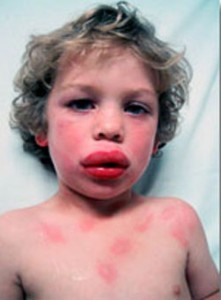Food allergy is not so common phenomena but many people misunderstand a food intolerance to food allrgies. Almost everyone is affected food intolerances at some point but people find it difficult to distinguish them to food allergies . When there is a unpleasant reaction after eating something it is mostly reffered as food allergy. Food allergies affect only 4-5% people actually.
 Their is a big difference between food allergy and food intolerance and if you are not able to identify between them it could turn into a serious concern for your child one day. Food allergy is an unusual and abnormal response to a particular food which is triggered by the adverse effets of that food on your immune system. These allergies are showed by specific symptoms. However, a food intolerance is also resulted by the reaction of the body to a food and it also has many symptoms but these symptoms are not caused by the immunological system. Food poisoning and toxic reactions also falls under food intolerances. Food intolerances are more prevalent than allergies and happens in a large variety of diseases unlike allergies.
Their is a big difference between food allergy and food intolerance and if you are not able to identify between them it could turn into a serious concern for your child one day. Food allergy is an unusual and abnormal response to a particular food which is triggered by the adverse effets of that food on your immune system. These allergies are showed by specific symptoms. However, a food intolerance is also resulted by the reaction of the body to a food and it also has many symptoms but these symptoms are not caused by the immunological system. Food poisoning and toxic reactions also falls under food intolerances. Food intolerances are more prevalent than allergies and happens in a large variety of diseases unlike allergies.
HOW AN ALLERGIC REACTION STARTS –
When the child eats any food in which some allergen components are present he feels uneasyness and allergic symptoms. It is because the allergen component manages to reach the bloodstream and then targets specific body parts which make noticeable changes. The reason behind food allergies to your child is either immune system or heridity.
IMMUNE SYSTEM –
Two components of the immune system are involved in the process. One is an allergy antibody IMMUNOGLOBULIN E which circulates through the blood and the other is called MAST CELL. Mast cell is particularly found in the places which usually reflects any allergy more considerably like nose, throat, lungs, skin etc.
HEREDITY –
The tendency of a child to react to a such an innocuous thing like food is inherited most of the times. A child with two parents having allergic history is more likeky to catch food allergies as compared to a child with a single parent with a allergic history. Parent’s history of allergies does not contain only food allergies but others too.
The symptoms of food allergies may differ with the type of allergy and the targeted body part. Lighter allergies may cause itching or little sensation at some parts but in severe cases inflammation, increased itching and sensation or red coloured spots with rashes apppear on the skin.
HOW TO TREAT FOOD ALLERGIES –
- Dietary avoidance – If the food that causes allergy to your child is known, avoid it.
- Safety – Wear a inscribed bracelet about your food allergies so that you will not eat an accidentaly served harmful food.
- Carry instant relief medicines etc.